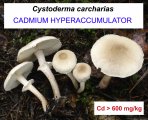Cadmium hyperaccumulation and its chemical form in Cystoderma carcharias
Macrofungi (mushrooms) may accumulate high concentrations of toxic metals in their fruit-bodies. The team led by Jan Borovička of the Department of Environmental Geology and Geochemistry (GLI) has focused on the saprotrophic fungus Cystoderma carcharias. According to the joint study published together with collaborating laboratories (University of Chemistry and Technology Prague, University of Graz, Nuclear Physics Institute CAS, Charles University), cadmium concentrations in C. carcharias are elevated at pristine sites. However, concentrations reaching 600 mg/kg in dry weight, the highest ever reported in macrofungi under natural conditions, have been found from a polluted site in the vicinity of Příbram (Central Bohemia, Czech Republic). In the study published in Science of the Total Environment (IF 4.610) the authors investigated the chemical species of the accumulated elements, particularly cadmium and arsenic. Cadmium appeared to be associated with specific proteins (possibly metallothioneins) but arsenic was present in numerous low-molecular-weight methylated compounds of which two have been known only from marine environments yet.


